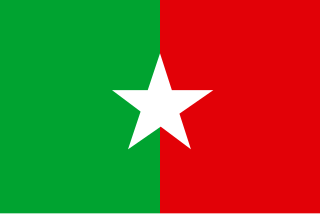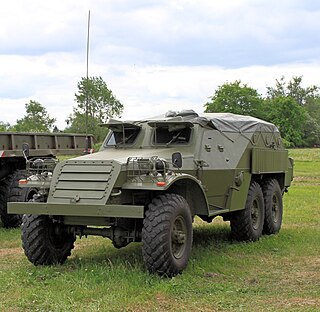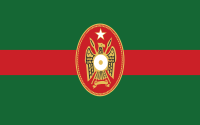
The Djibouti Armed Forces are the military forces of Djibouti. They consist of the Djiboutian National Army and its sub-branches the Djiboutian Air Force and Djiboutian Navy. As of 2018, the Djibouti Armed Forces consists of 20,470 ground troops, which are divided into several regiments and battalions garrisoned in various areas throughout the country. The Djibouti Armed Forces are an important player in the Bab-el-Mandeb and Red Sea.

The Somali Armed Forces are the military forces of the Federal Republic of Somalia. Headed by the president as commander-in-chief, they are constitutionally mandated to ensure the nation's sovereignty, independence and territorial integrity.

Ogaden is one of the historical names used for the modern Somali Region which forms the eastern portion of Ethiopia and which borders Somalia. Before 1995 most of Ogaden was part of Ethopia's Hararghe province. The other names sometimes used for this area are Haud or Hawd.

The Western Somali Liberation Front was a separatist rebel group fighting in eastern Ethiopia to liberate the Ogaden region from Ethiopian control. It played a major role in the Ogaden War of 1977-78 assisting the invading Somali Army.

The BTR-152 is a six-wheeled Soviet armored personnel carrier (APC) built on the chassis and drive train of a ZIS-151 utility truck. It entered service with a number of Warsaw Pact member states beginning in 1950, and formed the mainstay of Soviet motor rifle battalions until the advent of the amphibious BTR-60 series during the 1960s. BTR stands for bronetransportyor.

The Ogaden War, also known as the Ethio-Somali War, was a military conflict fought between Somalia and Ethiopia from July 1977 to March 1978 over the Ethiopian region of Ogaden. Somalia's invasion of the region, precursor to the wider war, met with the Soviet Union's disapproval, leading the superpower to end its support of Somalia and support Ethiopia instead.

The BTR-40 is a Soviet open-topped, wheeled armoured personnel carrier and reconnaissance vehicle. It is often referred to as the Sorokovka in Soviet service. It was eventually replaced in the APC role by the BTR-152 and in the scout car role by the BRDM-1.

The Somaliland National Armed Forces are the military services of the Republic of Somaliland. The Somaliland National Armed Forces consist of the Somaliland National Army, the Somaliland Coast Guard, the Somaliland Police Force, the Somaliland Custodial Corps, the Somaliland Immigration and Border Control and the Somaliland Fire Brigade. There is no air force. The Armed Forces is under the command of President Muse Bihi Abdi, who is the Commander-in-chief. Minister of Defence Abdiqani Mohamoud Aateye is the designated minister that oversees the armed forces.

The Ethiopian–Somali conflict is a territorial and political dispute between Ethiopia, Somalia, and Insurgents, Originating in the 1300's, the conflicts most recent iteration began in the late 1940s, when the Somali-inhabited Ogaden region was handed back to Ethiopia by the British. In the years following, tensions culminated in numerous insurgencies and several wars. However, because of the Somali Civil War and the lack of a functioning central government since the collapse of the Democratic Republic of Somalia in 1991, Ethiopia has the upper hand militarily and economically.
The 1982 Ethiopian–Somali Border War occurred between June and August 1982 when Ethiopia, sending a 10,000 man invasion force backed by warplanes and armored units, supported by thousands of SSDF rebels invaded Central Somalia. The United States government responded by speeding up deliveries of light arms and main battle tanks already promised. In addition, the initially pledged US$45 million in economic and military aid was increased to US$80 million.

The military history of Somalia encompasses the major conventional wars, conflicts and skirmishes involving the historic empires, kingdoms and sultanates in the territory of present-day Somalia, through to modern times. It also covers the martial traditions, military architecture and hardware employed by Somali armies and their opponents.

Ethiopia–Somalia relations are bilateral relations between Ethiopia and Somalia. These relations are characterized by the land border shared by the two countries and a number of military conflicts in past years.

The Battle of Jijiga was a series of battles that was part of the Ogaden War. The battles were fought in Jijiga, Ethiopia and was one the largest battles of the conflict.
The military history of Djibouti encompasses the major conflicts involving the historic empires and sultanates in the territory of present-day Djibouti, through to modern times. It also covers the martial traditions and hardware employed by Djiboutian armies and their opponents.

The 1964 Ethiopian–Somali Border War, or the First Ogaden War marked the first military conflict between the newly established Somali Republic and the Ethiopian Empire, lasting from February to April 1964. The war was preceded and ignited by a rebellion and insurgency in the Ogaden region, inhabited primarily by Somalis, which began in mid-1963. The suppression of insurgents and reprisals carried out by Emperor Haile Selassie's government resulted in a rapid decline in Ethio-Somali relations. Sporadic small-scale skirmishes between border police and Ethiopian airstrikes that began along the border in late 1963 escalated into large-scale warfare in early 1964. The conflict highlighted the disparity in military strength between the larger and highly equipped Ethiopian Imperial Army and the nascent Somali National Army, which had only formed during independence four years prior.

The Somaliland National Army, is the land force and largest branch of the Somaliland Armed Forces is based in the Somaliland capital of Hargeisa. There are approximately under 100,000 active members. The Somaliland National Army is composed entirely of professionals and volunteers due to the army not being mandatory of conscription. Some Somaliland battalions operate near the Puntland border due to a border dispute.
The Ethiopian Ground Forces is the land service branch of the Ethiopian National Defense Force. It is the senior of the two uniformed military branches. It engages in land warfare and combined arms operations, including armored and mechanized operations as well as air assault operations.

The Somali invasion of Ogaden took place in July 1977 when the Somali Army attacked in two formations. The main force had the aim of seizing Jijiga, Harar and Dire Dawa while a secondary force assaulted Dolo, Gode and Imi.

The Ethiopia–Somalia border stretches 1,500 kilometers. In the 19th century, both Britain and Italy contributed to shaping the modern border, on behalf of their colonies of British and Italian Somaliland. The Somali people were thus under British, French, Italian and Ethiopian rule. During World War II, Britain gained control of the Ogaden and Haud territories and returned them to Ethiopia in 1954, but not delimited beyond the provisional line. Since 1960 independence, the border suffered serious skirmish involving both countries soldiers. From 1977 to 1978, Ethiopia and Somalia fought Ogaden War led by Colonel Mengistu Haile Mariam and General Siad Barre respectively. The EPRDF government demarcated the border of Ogaden into Somali Region. Somalia is located at the base of Ethiopia's protrude southeast region; from South, it is bounded by Wabi Shebelle and Genale Valley.





























